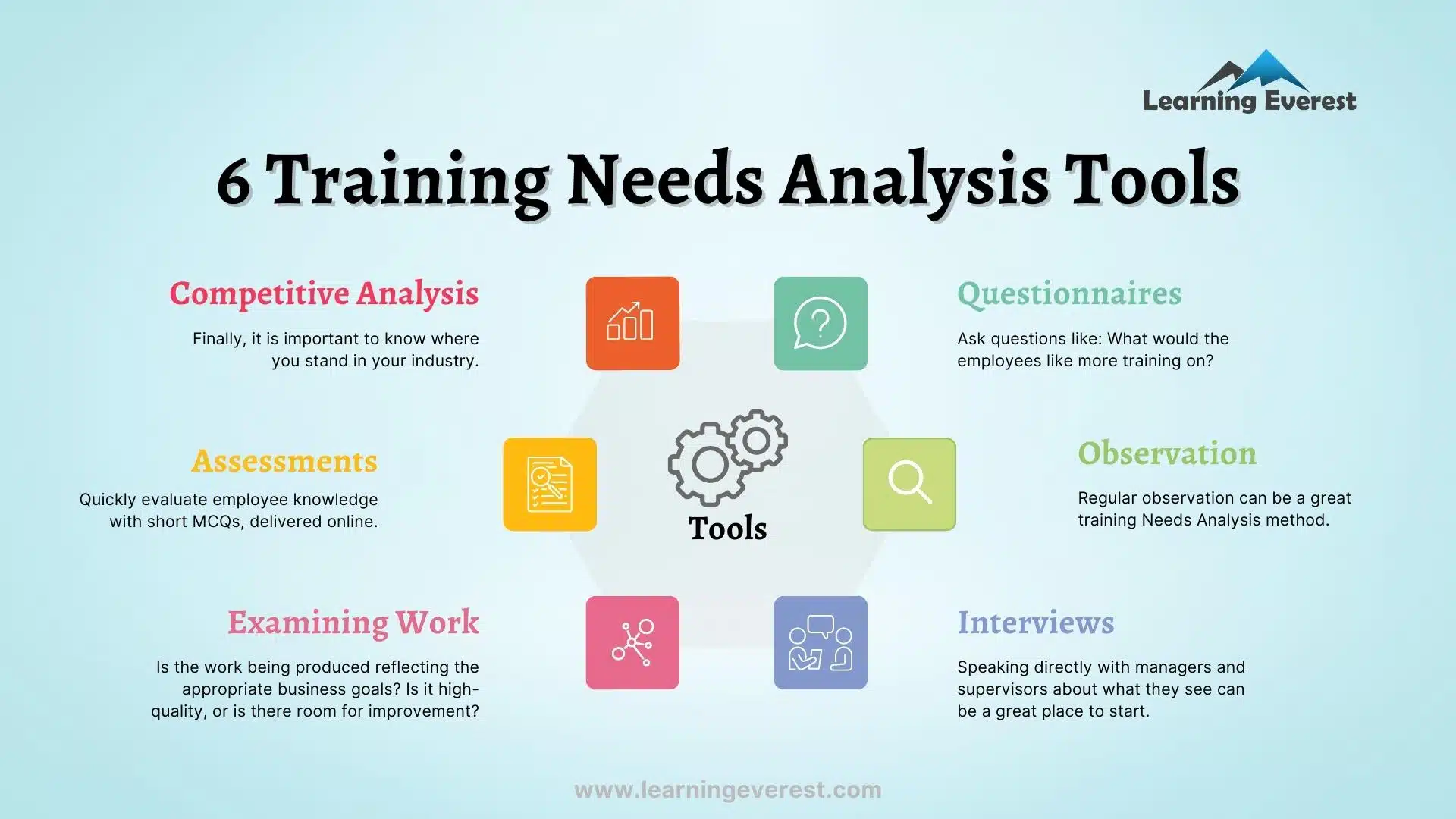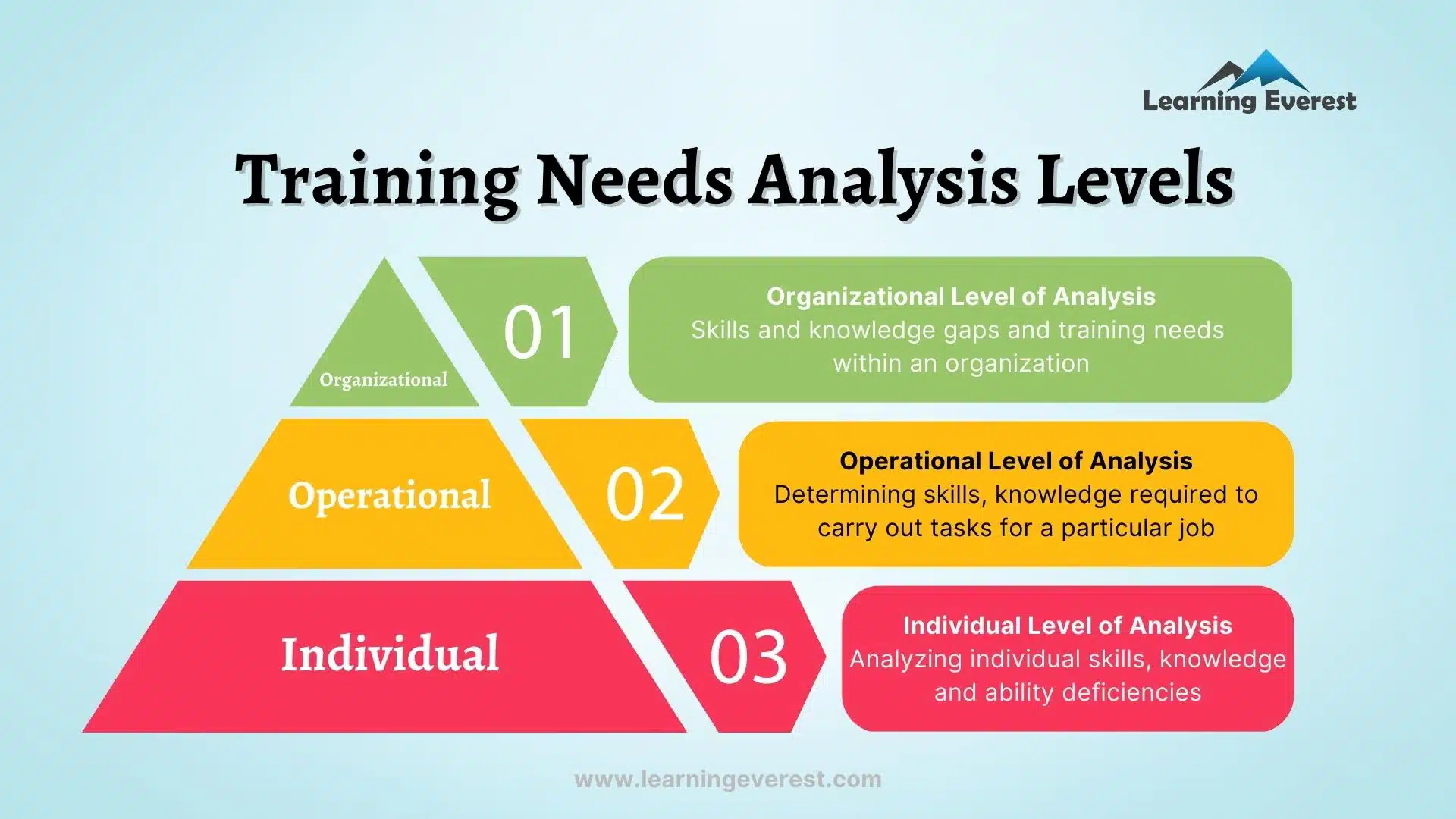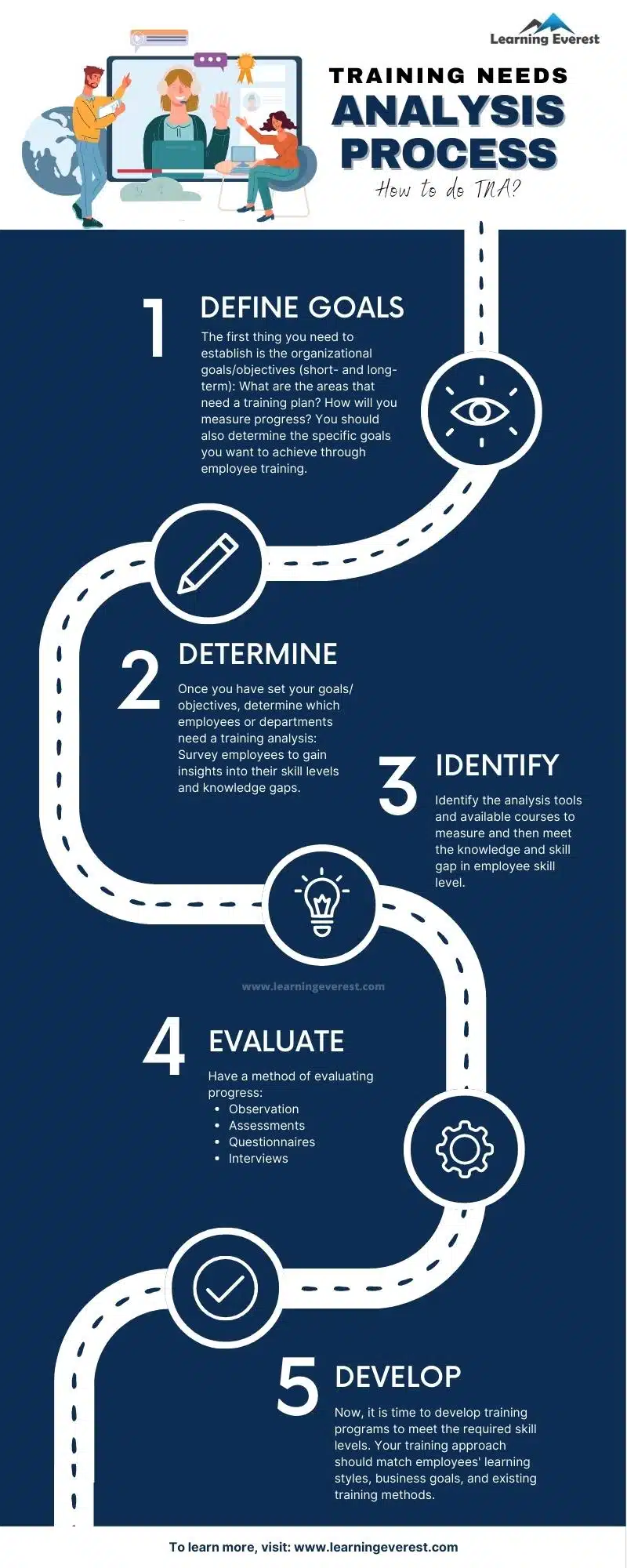Assessing organizational training needs is the diagnostic phase of a training plan and understanding the levels of Training Needs Analysis is a critical step. Identifying gaps in the training program is key to the assessment process.
Table of Contents
- Five steps of a training needs analysis
- The advantages of a training needs analysis
- Three levels of training needs analysis
- Infographics
- Knowledge Check!
- Conclusion
- Was this article helpful?
- Frequently Asked Questions (FAQs)
- How many types of training needs analysis are there?
- What are the three levels of training needs analysis?
- What are the five steps of a TNA?
- What is the purpose of a training needs analysis?
Training needs analysis (TNA) measures the competencies of an organization, a group, or an individual as they relate to what is required. It is important to find out if training will help and, if so, what kind of training is needed. Effective training programs consider questions like, who needs training? Who will do the training? What form will the training take? How will knowledge be transferred to the job? How will the training be evaluated?
A 2015 report on workplace training by 24×7 Learning Inc. found that just 11% of the employees can fully use the training in their job.
This statistic shows a significant disconnect between what the training organizations offer and what their employees need. It is crucial to understand what employees need to learn to address how employees learn. Training needs analysis includes issues related to employee and organizational performance to determine if training can help. It involves monitoring current performance using observation, interviews, and questionnaires, anticipating future failures, and identifying the type and level of training required.
Five steps of a training needs analysis
There are five steps for a training needs analysis:
- First, it is essential to identify the problem and the need for training analysis. Training needs analysis recognizes the gap in the training program.
- Next, it is important to determine the design of the training needs analysis. It determines the type and level of training.
- Then, the task is to collect data about the employees, and organization for the training needs analysis.
- After that, one should analyze the collected data.
- Next, it is important to provide feedback related to the training program. It contributes to determining what needs to be improved.

6 Training Needs Analysis Tools infographics
The advantages of a training needs analysis
By conducting a training needs analysis, one can have the following advantages:
- Identify the right material: Before a training program starts, the assessment will help to determine which policies, skills, and materials employees use daily. Then, the program can focus on the most important topics. It identifies performance goals and the knowledge, skills, and abilities needed for the workforce to achieve the desired goal.
- Recognizes the right audience: Training needs analysis will help determine which employees need training and how much training they need. A training needs analysis will enable the organizations to target the correct employee for each training session, ensuring everyone is following a personalized training plan so that they get the most benefit possible.
- Uses the proper method: A good training needs analysis will tell if there is a need for a new training program or if an alternative solution would be better. It will also determine the right method of training the employees. It also addresses resources required to fulfill the organizational mission, improve productivity, and provide quality products and services.
- Identifies training needs: Often, employers believe they know what their employees need to know, but there could be gaps in their knowledge. An assessment will help validate the training requirement. Training needs analysis recognizes the need for training.
- Helps to prioritize training needs: By conducting a training needs analysis, organizations find it easy to target the training which needs to be done at this point, and which training can be left for later.
- Prepare for specific jobs: Instead of training everyone in the same way, by conducting a training needs analysis, one can learn which programs are best for specific positions for a specific organization. It lets the employees upskill in their jobs at a faster rate and creates significant opportunities for their economic mobility.
- Structural improvement: Training needs analysis gives a structure to the program conducted by a series of analyses. The analysis helps to conduct the training program in a structural manner.
Three levels of training needs analysis
Training needs analysis is assessing which type and level of training are necessary. There are three levels of training needs analysis: organizational analysis, operational analysis, and individual analysis.

3 Critical Levels of Training Needs Analysis Infographics
Now let us discuss them in detail.
Organizational analysis
Training needs analysis is diagnosed by analyzing organizational outcomes and looking at future organizational needs. When doing an organizational analysis, it is important to consider how both internal and external variables can affect training. Training needs analysis at this level would start with a review of the organization’s strategic and operational plans. At this stage, organizations can ask questions like,
Who needs training?
Who will conduct the training?
What form will the training take?
Where is the training most required?
This level of analysis also incorporates things such as an organization’s culture, HR objectives, and external influences.
Operational analysis
A second level of analyzing training needs involves reviewing the jobs and tasks performed. Comparing employees’ skills in a job category to the skills needed for a successful job performance can recognize the gaps that can be filled by training. Organization asks the following questions,
To meet performance standards, how should employees complete this task?
How do employees perform this job?
What skills do employees need to achieve the performance standards?
What are the performance standards?
It usually means reviewing the competency needs and skill sets within a team against the team’s own objectives and desired business objectives. It will involve considering the needs of individuals and also anything that can help the organization to work together as effectively as possible.
Individual analysis
The third level of diagnosing training needs focuses on individuals and how they perform their jobs. The most common approach of individual analysis involves using performance appraisal data to assess training needs. Through the performance appraisal process, a supervisor first determines an employee’s performance strengths and inadequacies in a formal review. Then the supervisor can design training to help the employee overcome their weaknesses and enhance their strengths. At this stage, one should ask the following questions.
How do I want the employees to perform?
What is holding the employees back?
Do they have the right skills for this job?
What kind of training programs can help the employees reach the desired performance standards?
It contributes to determining what needs to be improved, whether through a training program they must take or other ongoing professional development. Because the trainees are in an excellent position to identify training needs, getting this kind of input can be helpful in gaining support for the training program from people who needs training.
Infographics
Knowledge Check!
Conclusion
To sum up, a training needs analysis can be highly helpful if done properly. The employees are more motivated, perform better, and have higher job satisfaction as a result. Additionally, it increases revenue, customer happiness, engagement, and engagement levels while decreasing waste, which increases productivity for the organization. Additionally, there will be opportunities for job advancement and stronger workplace culture.
Was this article helpful?
The following articles can also be useful guide as you get started:
- Training Needs Analysis, A Must For Successful Training
- What is TNA (Training Needs Analysis): 5 Great Advantages
Frequently Asked Questions (FAQs)
How many types of training needs analysis are there?
There are three fundamental sorts of training needs analysis.
What are the three levels of training needs analysis?
There are three sources used to analyze training needs: organizational analysis, operational analysis, and individual analysis.
What are the five steps of a TNA?
There are five steps as follows: identify the problem and needs for conducting a training analysis, determine the design of the needs analysis, collect data for the training needs analysis, analyze the collected data, and provide feedback.
What is the purpose of a training needs analysis?
Needs analysis measures the competencies of an organization, a group, or an individual as they see what is required. It is essential to figure out what is happening and what should be happening before deciding if training will help the employees and, if so, what kind of training is needed.







What models are used to determine the training needs for a company
Hi Patricia, In order to determine the training needs for a company, you will have to use McGhee and Thayer’s (1961) Three-Tiered Analysis and go ahead with the Organizational analysis using
1. Assessment Centers
2. Direct observation
3. Questionnaires
4. Interviews / consultation with persons in key positions, and/or with specific knowledge
5. Focus Group
6. Assessments/surveys
If you have to evaluate the effectiveness of the training program then you can use the Kirkpatrick Evaluation Model. You can read more about it here: https://www.learningeverest.com/the-kirkpatrick-evaluation-model-for-effective-training/
I need help to know more about the CBTA and TNA lesson plan
You can enroll for our Instructional Design course here: https://www.learningeverest.com/online-instructional-design-training/ and you will learn about the topic in depth.